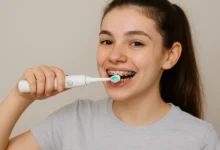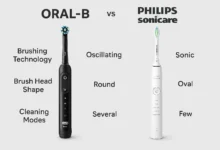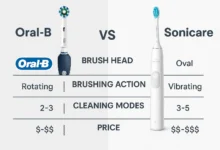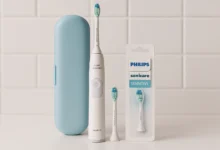Electric Toothbrush vs Manual: Which One Is Better for Your Smile?

Electric Toothbrush vs Manual: Which Is Best for Your Oral Health
Did you realize that an American Dental Association survey in 2024 found that more than three-fourths of those that had switched to an electric toothbrush said that their dentist had observed an improvement in their oral health? The controversy surrounding electric and manual toothbrushes has been going on in bathrooms and dental offices over the decades. But what is the science of it? Is it really better or is it a matter of taste?
This is an evidence-based extensive guide that cuts through all the marketing hype and provides the raw truth. We have compared the recent clinical research, talked to dental experts, and deconstructed the actual performance in the real world to answer one critical question: Which toothbrush is the one that fits you and your uniqueness in the terms of oral health needs?
Key Takeaways at a Glance
- Better Plaque Removal: Electric toothbrushes, especially, oscillating-rotating types are always found to remove more plaque and gingivitis compared to manual brushes.
- Gum Recession and Sensitivity: When properly performed, neither of the two types of gum procedures lead to gum recession; it is actually improper technique that is the root of the issue.
- Best for Special Requirements: Electric brushes have been strongly suggested to individuals with braces, arthritis, dexterity problems, or who have had poor brushing history.
- Which Brush is Best: This is the brush that you will use properly and regularly. Technique always wins over technology.
The Core Debate: What Does the Scientific Evidence Say?
Enough of the anecdotal evidence, now we will consider the hard data. Once the scientists undertake long-term medical studies that are controlled (so-called Cochrane Reviews, the gold standard in medical evidence), an example picture appears.
Landmark Studies and Systematic Reviews
A pivotal 2014 Cochrane Review, which analyzed data from 56 clinical trials, concluded that oscillating-rotating electric toothbrushes are significantly more effective than manual brushes. The review found:
- 21% more plaque reduction over 3 months.
- 11% greater reduction in gingivitis (gum inflammation).
However, more recent studies such as a 2023 study published in the International Journal of Dental Hygiene have reaffirmed these results with evidence indicating that even greater behavioral modification and clinical outcomes are achieved with the use of advanced electric models with pressure sensors and timers.
What about the NHS stance? The National Health Service (NHS) in the UK is categorical about the fact that some people could use electric toothbrushes as it could assist in easier brushing. They support the evidence that some electric brushes are a more effective at plaque removal.
Electric vs Manual Toothbrush: A Detailed Feature Comparison
To understand the real-world differences, let’s break down the key aspects side-by-side.
| Feature | Electric Toothbrush | Manual Toothbrush |
|---|---|---|
| Plaque & Gingivitis Reduction | Superior. Proven by numerous studies to be more effective, especially oscillating-rotating models. | Effective with perfect technique, but most people fall short. |
| Ease of Use & Motivation | High. Built-in timers, pressure sensors, and quadrant pacers guide users to better habits. Can be more engaging. | Relies entirely on user knowledge and discipline. Easier to brush incorrectly and for too short a time. |
| Cost (Initial & Long-Term) | Higher initial cost ($30-$250+). Ongoing cost for replacement heads ($10-$50 every 3-6 months). | Significantly lower. Initial cost ($2-$10). No ongoing costs beyond the brush itself every 3 months. |
| Portability & Convenience | Requires charging or batteries. Bulkier for travel. | Excellent. No charging, lightweight, and easy to pack. |
| Technique Required | Low. The brush does the motion; you just need to guide it slowly across all surfaces. | High. Requires knowledge and consistent execution of the proper Bass or modified Bass technique. |
| Ideal For | Those with limited dexterity, braces, a history of gum disease, poor brushing habits, or who want maximum efficacy. | Those with excellent technique, healthy gums, budget constraints, or a strong preference for simplicity. |
Addressing Your Biggest Concerns: Gum Recession, Braces, and Kids
Community forums like Reddit are filled with personal experiences and questions. Let’s address the most common ones with evidence-based answers.
Electric Toothbrush vs Manual for Gum Recession
This is a great source of perplexity. It is feared the gums will be scrubbed away by the vigorous action of an electric brush.
The Fact: Some studies show that the main reason behind gum recession and tooth abrasion is the incorrect brushing method rather than the type of brush. One of the worst offenders is the scrubbing back-and-forth using a hard-bristled manual brush.
Actually, most electronic toothbrushes these days have got pressure sensors, which light or pulse when you are brushing too hard. This makes quality electric brush a better option where people worry about recession since it is proactively stopping the harmful behavior.
Conclusion: Softer bristled electric brush with pressure sensor is a safer option in safeguarding gums as opposed to a manual one that is operated with excessive force.
Electric Toothbrush vs Manual for Braces

It is famous that cleaning around brackets and wires is hard. The particles of food and plaque are easily enclosed, resulting in white spots (decalcification) and cavities.
Complex actions of an electric toothbrush, particularly oscillating-rotating heads are remarkably effective in destabilizing the plaque around orthodontic devices. They are able to polish the surfaces of the bracket, the gumline and the tooth surface above and beneath the wire more effectively than most individuals are capable of doing manually.
Conclusion: an electric toothbrush is a highly recommended product to those people having braces. It makes a challenging job easy, and offers a far superior quality of clean, safeguarding your investment in a straight smile.
Electric Toothbrush vs Manual for Kids

The goal with children is to instill good habits and make brushing fun, not a chore.
Electric toothbrushes designed for kids often feature:
- Timers with fun sounds or lights.
- App connectivity with games and rewards.
- Smaller, softer brush heads for delicate mouths.
These characteristics will go a long way to enhance compliance and see them brush the entire two minutes. The parents should, however, ensure that the child is pointing the brush in the right direction and not merely letting it buzz in front of his or her front teeth.
Verdict: A child-safe electric toothbrush may be an awesome engagement and effective cleaning tool. Nevertheless, a manual brush with proper usage is also an excellent and very affordable alternative.
Making the Right Choice: A 5-Step Decision Framework
Still unsure? Follow this step-by-step guide to find your perfect match.
Step 1: Be Honest with Your Brushing Technique and Habits.
Do you always brush two minutes twice a day? Do you focus on the gumline? When you are not consistent or have doubts about your style, the guide manual that comes with an electric brush can be a boon.
Step 2: Assess Your own Oral Health and Objectives.
Do you have cavities, gingivitis or braces? Are you prevention oriented? In case your oral hygiene requires some boost, the enhanced cleaning of an electric brush is a prudent investment.
Step 3: Take into Account the physical constraints.
Do you have arthritis, carpal tunnel, or other ailments that interfere with your grip or movement? The act of moving an electric brush is much less dexterating and demanding of effort.
Step 4: Weigh Your Budget
Be realistic on the combined costs of ownership. Are you comfortably able to afford the initial unit and continuing cost of replacement heads? Otherwise, a manual brush that you select meticulously and use perfectly is much superior to an electric brush that you cannot afford to maintain.
Step 5: Take into Account Your Personality.
Are you a techno-lover, or are you a data-lover? You could be encouraged by the characteristics of a luxurious electric brush. Or are you more inclined to simplicity and to minimalism? No shame in picking a manual brush in case it will be used every time and in the right way.
Pro Tips for Maximizing Your Brush’s Performance
Regardless of your choice, technique is paramount.
If You Choose an Electric Toothbrush:
- Don’t Rub: Have the brush do it. Gently move the moving head over tooth surfaces stopping and taking some time on each tooth.
- 45 Degrees: Tilting the bristles directly at the gumline will cleanse the key crevice where the plaque builds up.
- Trust the Timer: Brush two full minutes, with the quadrant pacer, if you have it.
- Listen to Pressure Sensor: When it goes on, then you are pushing too hard. Ease-up to save your gums and enamel.
If You Choose a Manual Toothbrush:
- Apply the Right Technique: Study the Bass technique. Apply short, soft, back and forth vibrations with 90 degrees to the gums. Do not use rough sawing movements.
Set a Separate Timer: Two minutes is not as short as you believe. A phone timer or an hourglass will help make sure that you brush long enough.
Select Soft Bristles: It is always important to buy a brush whose bristles are soft or extra-soft. Hard bristles are injurious and unnecessarily.
Frequently Asked Questions (FAQ)
Are electric toothbrushes really better than manual?
Yes, according to much of scientific evidence, electric toothbrushes, namely oscillating-rotating types, prove more effective at plaque and gingivitis prevention in an average person. They counteract the typical imperfections in brushing process and time.
Will electric toothbrush recede the gums?
Not if used correctly. Brushing excessively with an incorrect technique is the major cause of gum recession. To avoid this, most electric brushes are fitted with pressure sensors, and they are safer as compared to a manual brush when excessive pressure is applied.
Is it good enough to have a manual toothbrush?
Absolutely. A manual toothbrush with good technique over the entire two minutes, twice a day is absolutely effective in keeping the mouth healthy. The issue is that it is a very rare individual who meets this ideal standard all the time.
Which is the most affordable electric toothbrush?
You should find qualified brands, such as Oral-B or entry-level models of Philips Sonicare. They are also priced between 30-50 dollars and they contain the essentials such as a two-minute timer and alert pressure without the high price tag. Do not forget to include the replacement head cost.
I have sensitive teeth. Which is better?
A toothbrush that features a force sensor and a sensitive mode is usually a good option as well as an electric one. It gives a softer wash but at the same time you do not brush too hard and make your sensibility worse. A soft-bristled head must always be used.
Viewpoint: The Final Verdict.
That leaves you with a dilemma, what should you use an electric toothbrush or a manual one?
The objective facts are also evident: superior quality electric toothbrushes provide better cleaning results of most individuals in a clinically superior way. They are better in removing more plaque, they are better in reducing the gingivitis and they have built-in features that encourage better brushing habits. They are especially beneficial to individuals who have braces, dexterity problems, or a history of having difficulty with the maintenance of oral health.
Nevertheless, a manual toothbrush is not out-dated. It is a very efficient, cheap and portable instrument in the hands of a perfect technique and consistency.
Your Next Move: You have a distinctive smile. Talk with your dentist or dental hygienist about your oral health, habits and goals, at your next appointment. They are able to recommend something that is more personalized and takes into account the science, your budget and your lifestyle. It does not matter whether you are going with electric or manual, what is important is that you will commit to using it right, two times a day, every day.
This article is not medical advice, it is written in an informational manner. Get in touch with a qualified healthcare practitioner to receive individual dental advice.
Fastest Teeth Whitening Methods: Get a Brighter Smile Quickly



